Synthesis, Molecular Structure and Spectral Properties of Quaternary Ammonium Derivatives of 1,1-Dimethyl-1,3-propylenediamine
Abstract
:Introduction
Results and Discussion
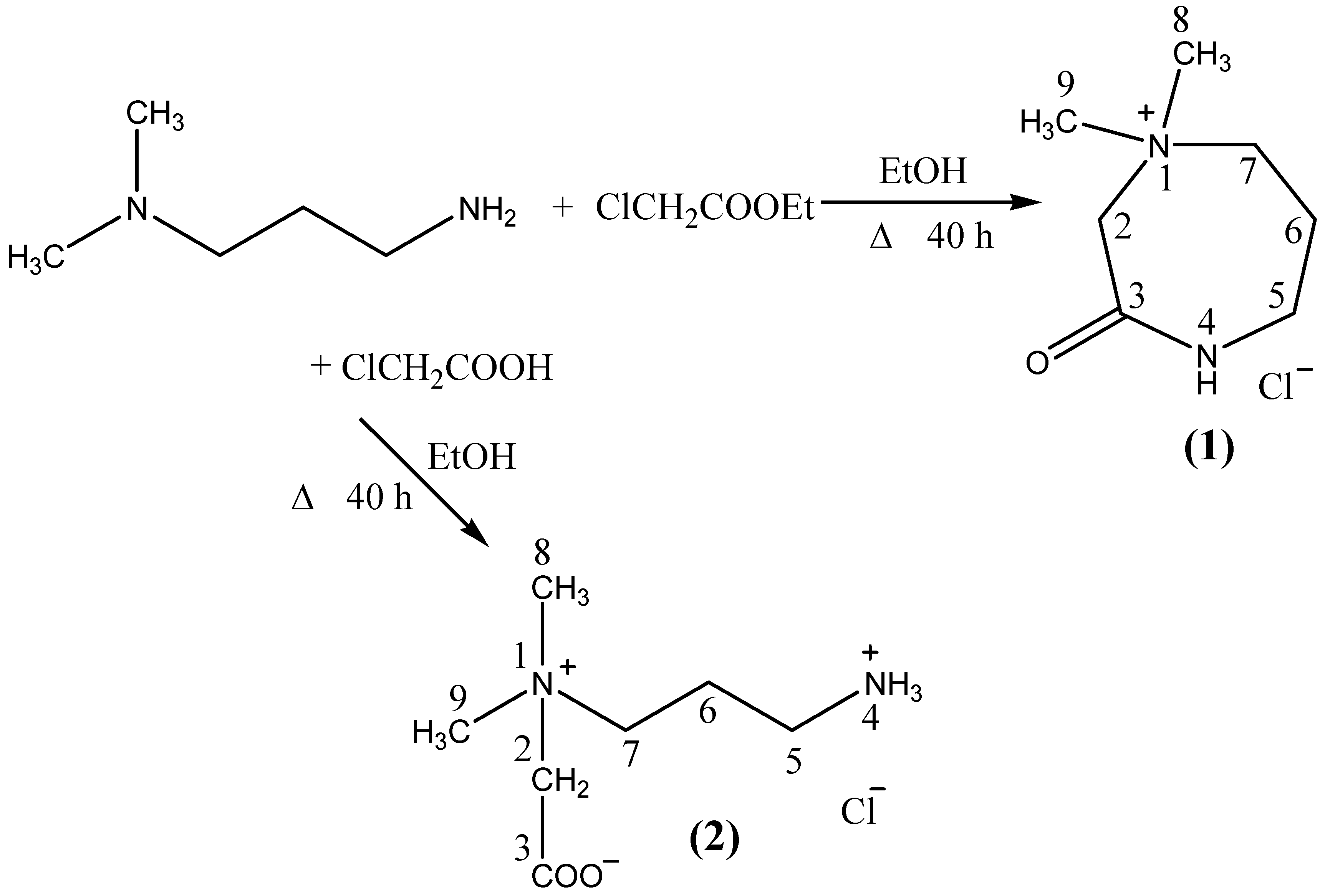
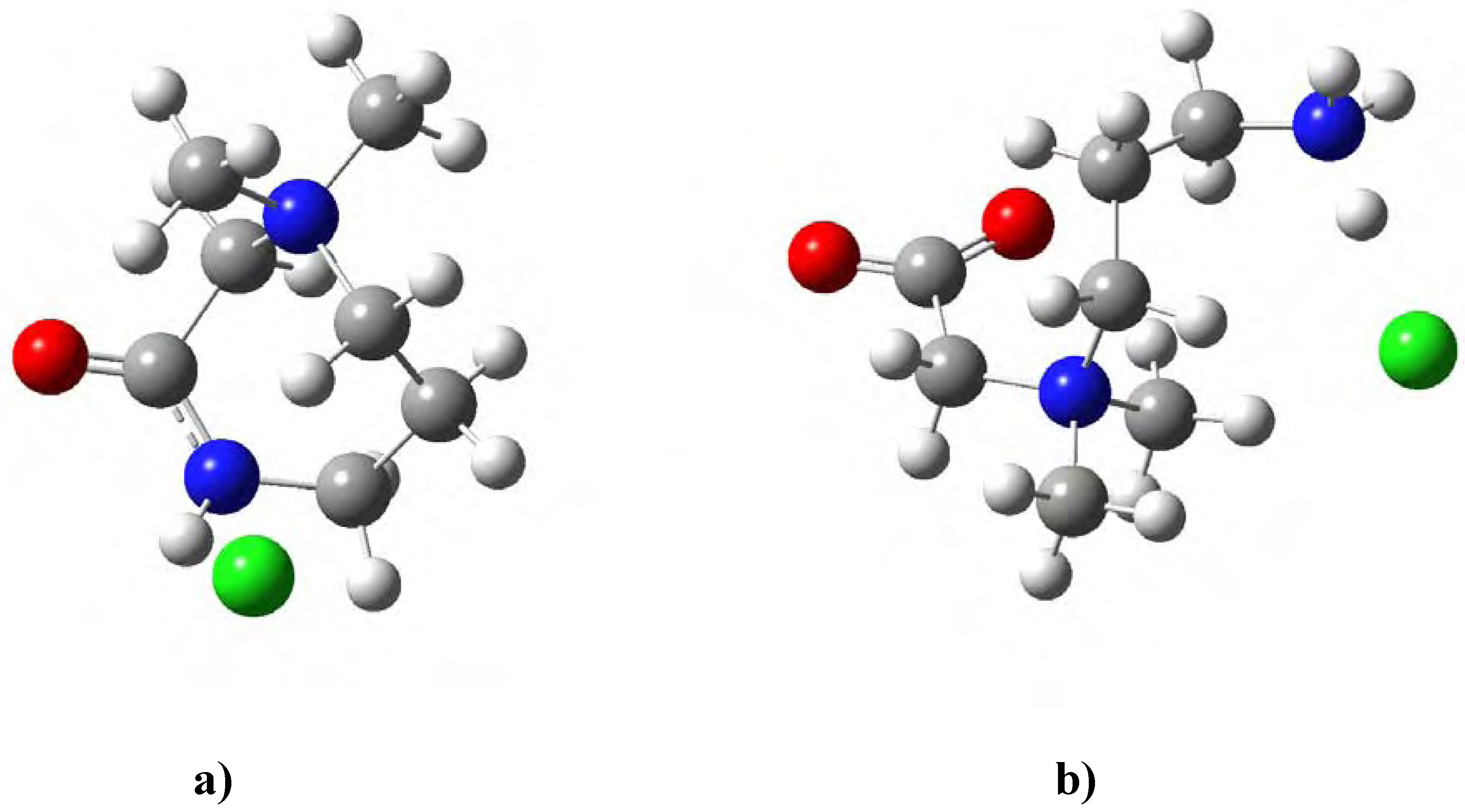
| Parameters | Compound | |
|---|---|---|
| 1 | 2 | |
| Energy (a.u) | -920.693398 | -997.308310 |
| Dipole moment (Debye) | 14.9394 | 5.7351 |
| C(3)=O (Å) | 1.227 | 1.253, 1.232 |
| N(4)···Cl (Å) | 3.001 | 2.906 |
| N(4)-H (Å) | 1.042 | 1.133 |
| N(4)-H·Cl (deg.) | 135.3 | 177.1 |
| N(1)··· Cl (Å) | 4.470 | 4.066 |
| N(1)··· O (Å) | 3.201 | 2.944 |
| C(7)··· O (Å) | 3.201 | 2.901 |
| N(4)-C(3) (Å3) | 1.351 | - |
| N(4)-C(5)-C(6)-C(7) (deg) | -8.58 | -67.64 |
| N(1)-C(2)-C(3)-N(4) (deg) | -81.64 | - |
| N(1)-C(2)-C(3)-O (deg) | 93.13 | 9.75, -170.8 |
| N(1)-C(7)-C(6)-C(5) (deg) | -67.74 | -73.15 |
| C(2)-C(3)-N(4)-C(5) (deg) | 0.35 | - |
FTIR study
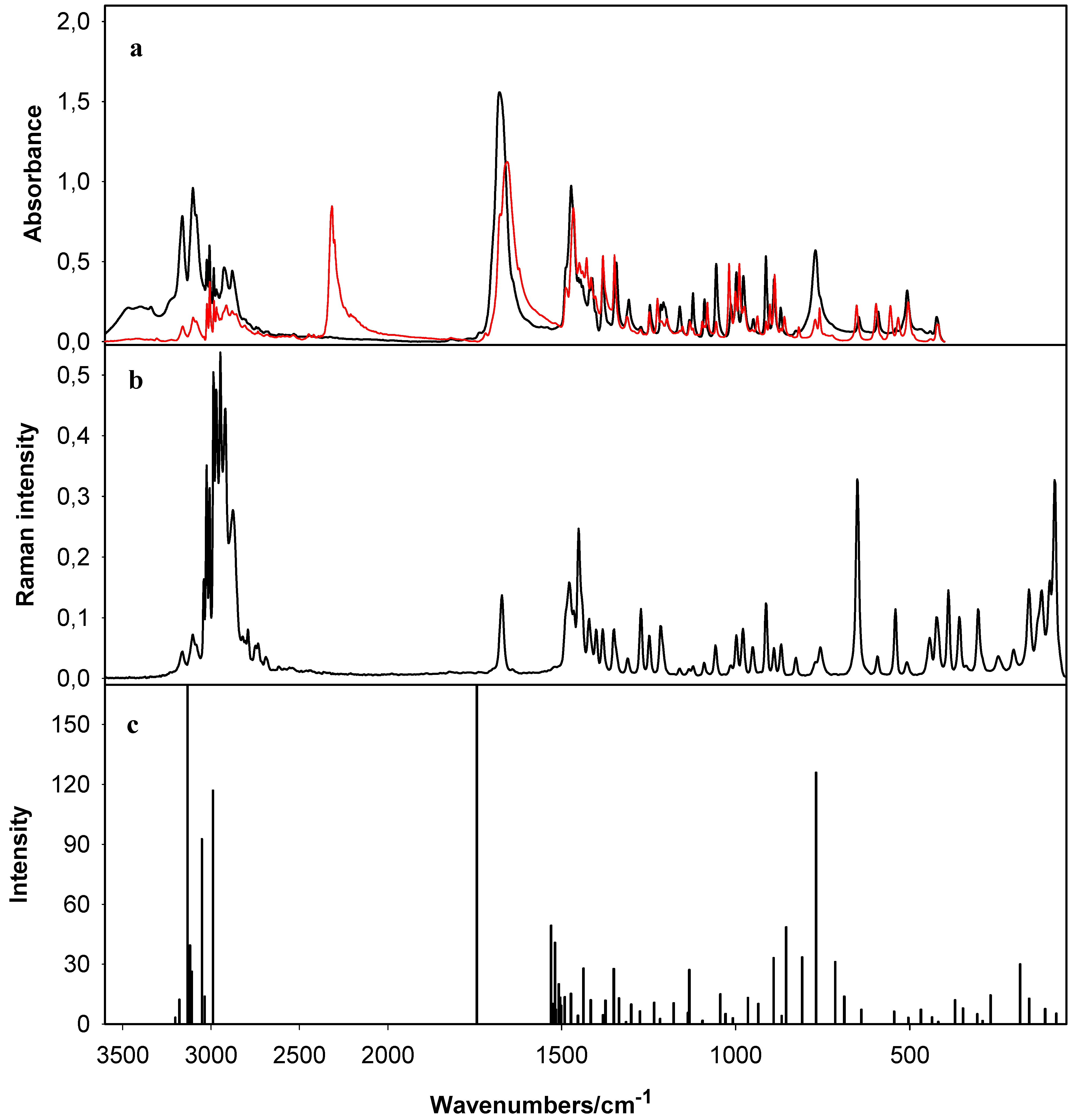
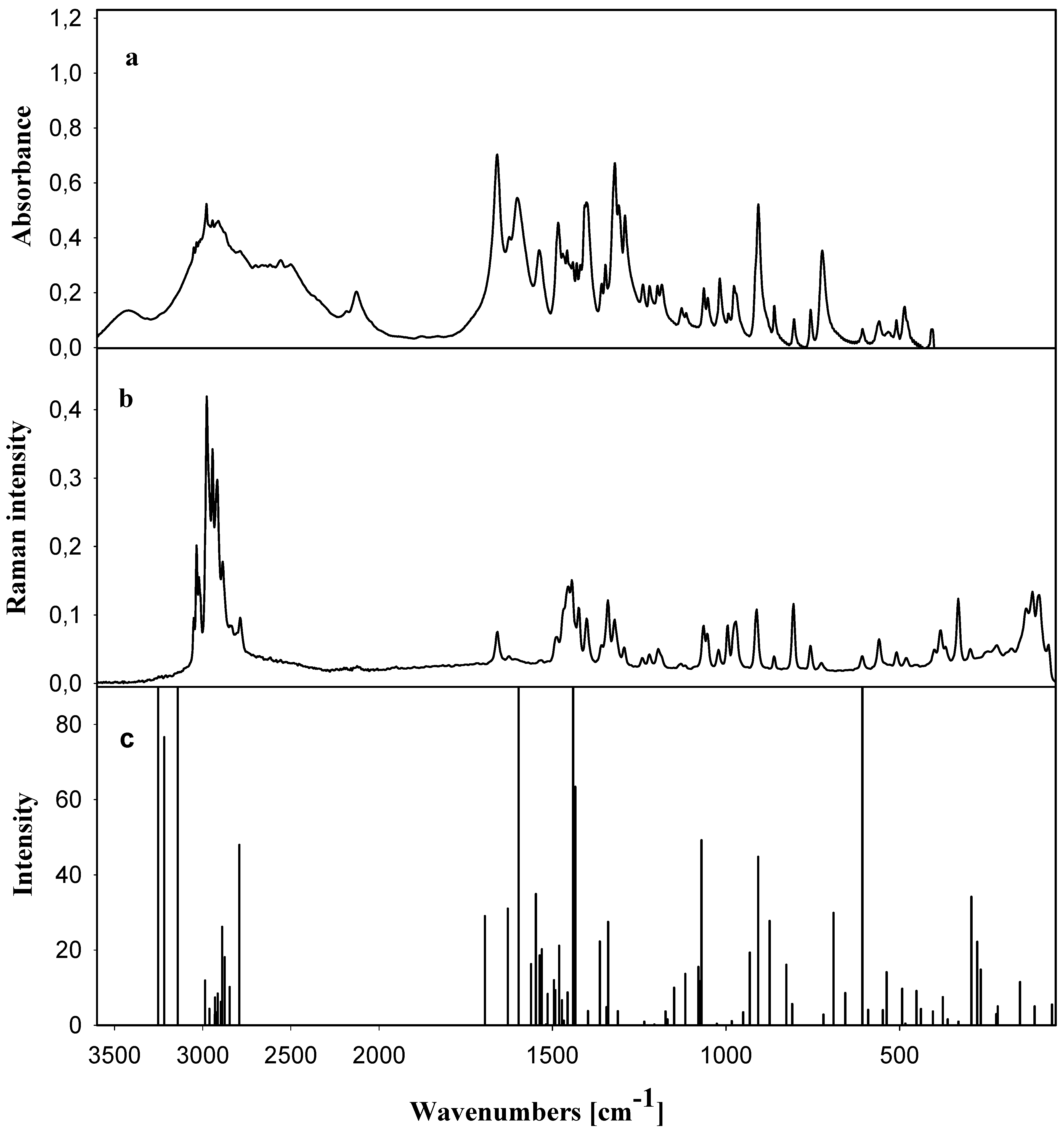
1H- and 13C-NMR study
| δexp. | δcalc | σcalc | δexp. | δcalc | σcalc | ||
|---|---|---|---|---|---|---|---|
| 1,1-Dimethyl- 3-oxo-1,4-diazepan-1-ium chloride (1) | |||||||
| 13C | 1H | ||||||
| C (8,9) | 42.2 | 55.2 | 140.5 | H (8,9) | 3.31 | 3.42 | 28.73 |
| C (2) | 71.1 | 69.4 | 127.6 | H (2) | 4.35 | 3.45 | 28.70 |
| C (3) | 170.0 | 168.1 | 38.0 | H (5) | 3.50 | 4.04 | 28.11 |
| C (5) | 55.9 | 44.1 | 150.6 | H (6) | 2.24 | 2.58 | 29.57 |
| C (6) | 27.2 | 25.8 | 167.2 | H (7) | 3.80 | 3.73 | 28.42 |
| C (7) | 69.6 | 73.4 | 124.0 | ||||
| a | 209.9207 | 32.1455 | |||||
| b | -1.1011 | -0.9999 | |||||
| r | 0.9869 | 0.6998 | |||||
| 1,1-Dimethyl-1-carboxymethyl-3-aminopropyl ammonium hydrochloride (2) | |||||||
| 13C | 1H | ||||||
| C (8,9) | 54.4 | 50.4 | 129.0 | H (8,9) | 3.27 | 3.28 | 28.66 |
| C (2) | 66.5 | 66.3 | 114.8 | H (2) | 3.93 | 3.24 | 28.70 |
| C (3) | 171.4 | 172.0 | 19.5 | H (5) | 3.70 | 3.25 | 28.01 |
| C (5) | 63.4 | 63.4 | 117.4 | H (6) | 2.18 | 2.36 | 29.69 |
| C (6) | 23.6 | 25.5 | 151.7 | H (7) | 3.10 | 3.44 | 28.47 |
| C (7) | 39.2 | 40.7 | 137.9 | ||||
| a | 193.5479 | 28.6193 | |||||
| b | -1.1085 | -0.8843 | |||||
| r | 0.9992 | 0.8030 | |||||
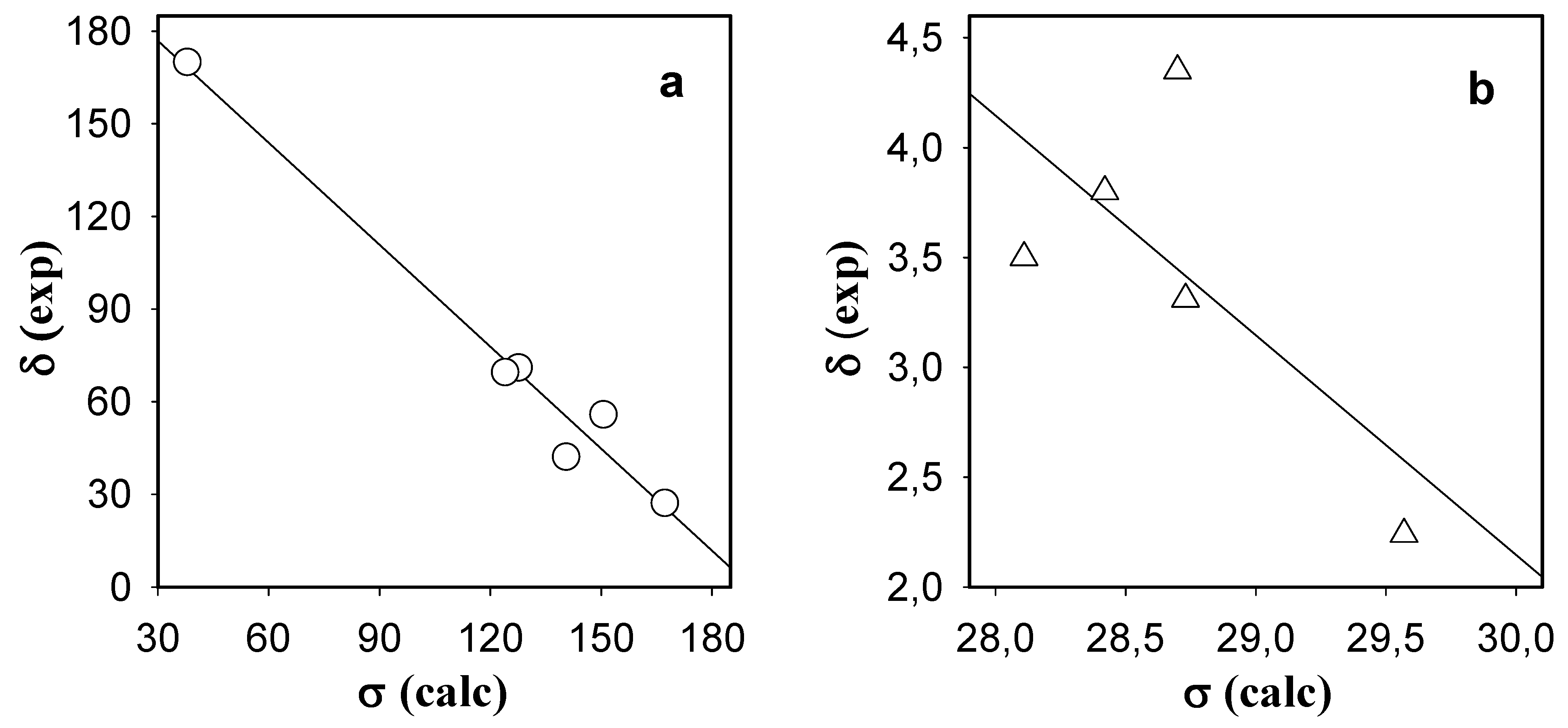
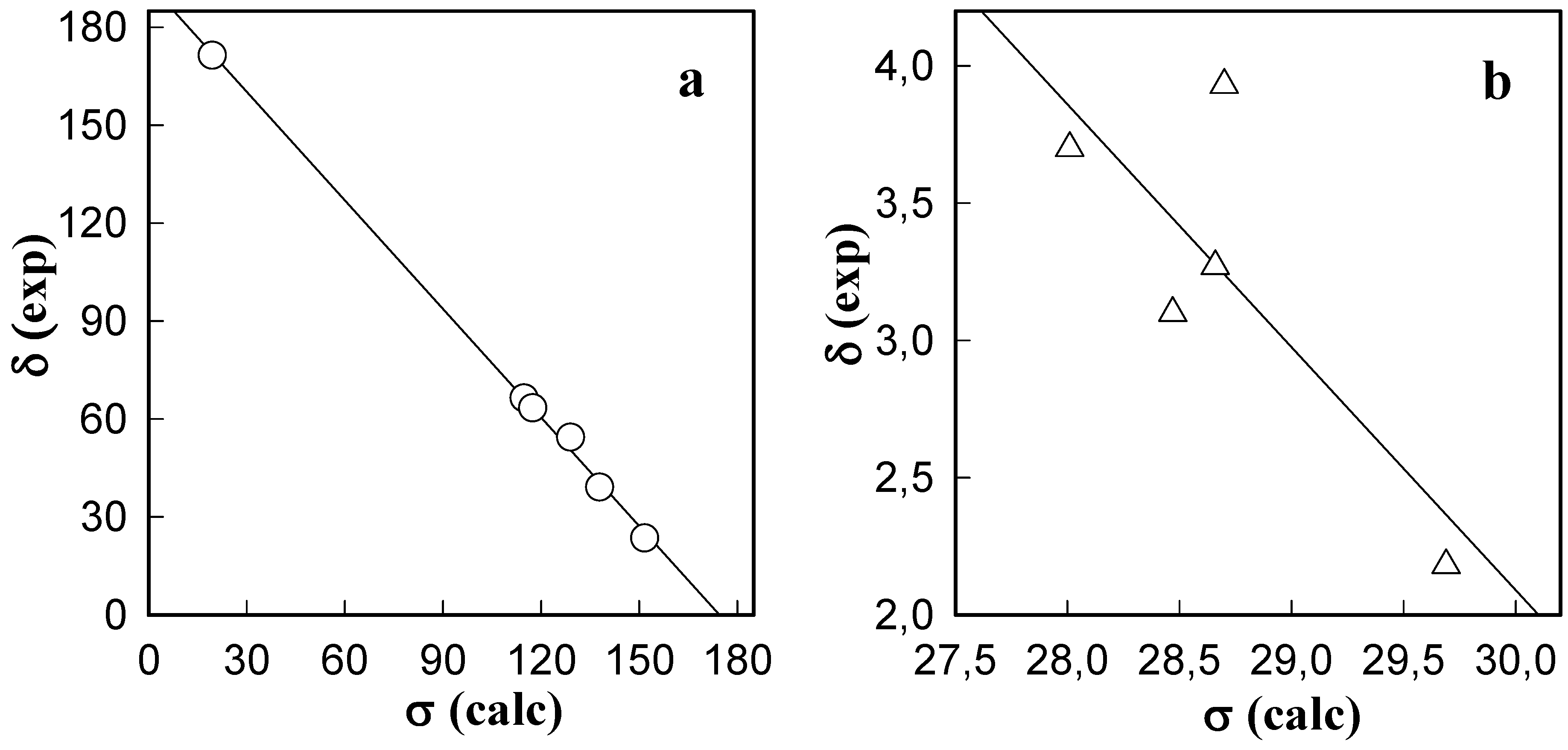
Conclusions
Experimental
General
Computational Details
Syntheses
1,1-Dimethyl-3-oxo-1,4-diazepan-1-ium chloride (1)
N,N-dimethyl-N-carboxymethyl-3-aminopropyl ammonium hydrochloride (2).
Acknowledgements
References
- Karigiannis, G.; Papaioannou, D. Structure, Biological Activity and Synthesis of Polyamine Analogues and Conjugates. Eur. J. Org. Chem. 2000, 2000, 1841–1863. [Google Scholar] [CrossRef]
- Wallace, H. M.; Fraser, A.V.; Hughes, A. A perspective of polyamine metabolism. Biochem. J. 2003, 376, 1–14. [Google Scholar] [CrossRef] [PubMed]
- Majtan, V.; Majtanova, L. Effect of quaternary ammonium salts and amine oxides on the surface hydrophobicity of Enterobacter cloacae. Chem. Papers 2000, 54, 49–52. [Google Scholar]
- Devinsky, F.; Masarova, L.; Lacko, L.; Mlynarcik, D. Synthesis, IR spectra, and antimicrobial activity of some bis-ammonium salts of N,N’-bis(2-dimethylaminoethyl)methylamine. Coll. Czech. Chem. Commun. 1984, 49, 2819–2827. [Google Scholar] [CrossRef]
- Jones, R.A. Quaternary Ammonium Salts. Their Use in Phase-Transfer Catalysis; Academic Press: San Diego, CA, USA, 2001. [Google Scholar]
- Fraise, A. P.; Lambert, P.A.; Maillard, J-Y. (Eds.) Russell, Hugo & Ayliffe’s Principles and Practice of Disinfection, Preservation and Sterilization; Blackwell Publishing: Birmingham, UK, 2004.
- Block, S.S. (Ed.) Disinfection, Sterilization, and Preservation, 5th ed.; Lippincott Williams & Wilkins: Philadephia, 2001.
- Brycki, B.; Werner, J.; Kowalczyk, I. Synthesis and spectroscopic properties of N,N-bis-(3-aminopropyl)-N,N-dialkylammonium salts. Ann. Pol. Chem. 2005, 1, 192–195. [Google Scholar]
- Domingo, X. “Betaines” in Amphoteric Surfactants; Lomax, E.G., Ed.; Marcel Dekker: New York, 1996; pp. 76–190. [Google Scholar]
- Schaack, G. Experimental results on phase transitions in betaine compounds. Ferroelectrics 1990, 104, 147–158. [Google Scholar] [CrossRef]
- Szafran, M.; Kowalczyk, I.; Koput, J.; Katrusiak, A. X-ray and DFT studies of structure, vibrational and NMR spectra of 2-amino-pyridine betaine hydrochloride. J. Mol. Struct. 2005, 744-747, 59–67. [Google Scholar]
- Kröhnke, F.; Schnegelberger, H.; Weis, W. Synthesen von 1-Hydroxy-dehydrochinolizinium-, Oxa- und Aza-dehydrochinoliziniumsalzen. Chem. Ber. 1964, 97, 3566–3576. [Google Scholar] [CrossRef]
- Szafran, M.; Kowalczyk, I.; Katrusiak, A. Crystal and molecular structure of 3-(2-amino-pyridinium)-propionate monohydrate. J. Mol. Struct. 2006, 786, 25–32. [Google Scholar] [CrossRef]
- Kowalczyk, I.; Szafran, M. Synthesis, spectral and B3LYP analysis of 1-R-2-oxo-pyrido[2,1b][3,4]dihydro-pyrimidinium halides. ARKIVOC 2007, VI, 55–63. [Google Scholar]
- Szafran, M.; Kowalczyk, I.; Katrusiak, A. Prototropic equilibrium between 1-H-2-oxopyrido-[2,1b][3,4]dihydropyrimidinium chloride and 3-(2-aminopyridinium)propionate hydrochloride studied by X-ray, FTIR, Raman, NMR and ab initio methods. J. Mol. Struct. [CrossRef]
- Melandri, M.; Buttini, A.; Degiuli, G. New heterocyclic compounds containing a quaternary N+H3 group. Boll. Chim. Farm. 1964, 103, 895–903. [Google Scholar] [PubMed]
- Wlodarczyk, N.; Gilleron, P.; Millet, R.; Houssin, R.; Henichart, J.-P. Synthesis of 1,4-diazepin-5-ones under microwave irradiation and their reduction products. Tetrahedron Lett. 2007, 48, 2583–2586. [Google Scholar] [CrossRef]
- Buyukmurat, Y.; Akyuz, S. Theoretical and experimental studies of IR spectra of 4-aminopyridine metal(II) complexes. J. Mol. Struct. 2003, 651-653, 533–539. [Google Scholar]
- Harmon, K.M.; Avci, G.F. Hydrogen bonding : Part 15. Infrared study of hydrogen bonding in betaine hydrate and betaine hydrofluoride. J. Mol. Struct. 1984, 117, 295–302. [Google Scholar]
- Ośmiałowski, B.; Kolehmainen, E.; Gawinecki, R. GIAO/DFT calculated chemical shifts of tautomeric species. 2-Phenacylpyridines and (Z)-2-(2-hydroxy-2-phenylvinyl)pyridines. Magn. Res. Chem. 2001, 39, 334–340. [Google Scholar]
- Frisch, M. J.; Trucks, G. W.; Schlegel, H. B.; Scuseria, G. E.; Robb, M. A.; Cheeseman, J. R.; Montgomery, J. A.; Vreven, T., Jr.; Kudin, K. N.; Burant, J. C.; Millam, J. M.; Iyengar, S. S.; Tomasi, J.; Barone, V.; Mennucci, B.; Cossi, M.; Scalmani, G.; Rega, N.; Petersson, G. A.; Nakatsuji, H.; Hada, M.; Ehara, M.; Toyota, K.; Fukuda, R.; Hasegawa, J.; Ishida, M.; Nakajima, T.; Honda, Y.; Kitao, O.; Nakai, H.; Klene, M. X.; Li; Knox, J. E.; Hratchian, H. P.; Cross, J. B.; Adamo, C.; Jaramillo, J.; Gomperts, R.; Stratmann, R. E.; Yazyev, O.; Austin, A.J.; Cammi, R.; Pomelli, C.; Ochterski, J. W.; Ayala, P. Y.; Morokuma, K.; Voth, G. A.; Salvador, P.; Dannenberg, J. J.; Zakrzewski, V. G.; Dapprich, S.; Daniels, A. D.; Strain, M. C.; Farkas, O.; Malick, D. K.; Rabuck, A. D.; Raghavachari, K.; Foresman, J. B.; Ortiz, J. V.; Cui, Q.; Baboul, A. G.; Clifford, S.; Cioslowski, J.; Stefanov, B. B.; Liu, G.; Liashenko, A.; Piskorz, P.; Komaromi, I.; Martin, R. L.; Fox, D. J.; Keith, T.; Al-Laham, M. A.; Peng, C.Y.; Nanayakkara, A.; Challacombe, M.; Gill, P. M. W.; Johnson, B.; Chen, W.; Wong, M. W.; Gonzalez, C.; Pople, J. A. Gaussian 03, Revision C.01; Gaussian, Inc.: Wallingford, CT, USA, 2004. [Google Scholar]
- Becke, A.D. Density-functional thermochemistry. III. The role of exact exchange. J. Chem. Phys. 1993, 98, 5648–5652. [Google Scholar]
- Becke, A.D. Density-functional thermochemistry. V. Systematic optimization of exchange-correlation functionals. J. Chem. Phys. 1997, 107, 8554–8560. [Google Scholar]
- Lee, C.; Yang, W.; Parr, G. R. Development of the Colle-Salvetti correlation-energy formula into a functional of the electron density. Phys. Rev. 1988, B 37, 785–789. [Google Scholar]
- Hehre, W. J.; Random, L.; Schleyer, P.V.R.; Pople, J.A. Ab Initio Molecular Orbital Theory; Wiley: New York, 1986. [Google Scholar]
- Dichfield, R. Self-consistent perturbation theory of diamagnetism I. A gauge-invariant LCAO method for N.M.R. chemical shifts. Mol. Phys. 1974, 27, 789–807. [Google Scholar]
- Wolinski, K.; Hilton, J.F.; Pulay, P. Efficient implementation of the gauge-independent atomic orbital method for NMR chemical shift calculations. J. Am. Chem. Soc. 1990, 112, 8251–8260. [Google Scholar] [CrossRef]
- Sample Availability: Contact the author.
© 2008 by MDPI (http://www.mdpi.org). Reproduction is permitted for noncommercial purposes.
Share and Cite
Kowalczyk, I. Synthesis, Molecular Structure and Spectral Properties of Quaternary Ammonium Derivatives of 1,1-Dimethyl-1,3-propylenediamine. Molecules 2008, 13, 379-390. https://doi.org/10.3390/molecules13020379
Kowalczyk I. Synthesis, Molecular Structure and Spectral Properties of Quaternary Ammonium Derivatives of 1,1-Dimethyl-1,3-propylenediamine. Molecules. 2008; 13(2):379-390. https://doi.org/10.3390/molecules13020379
Chicago/Turabian StyleKowalczyk, Iwona. 2008. "Synthesis, Molecular Structure and Spectral Properties of Quaternary Ammonium Derivatives of 1,1-Dimethyl-1,3-propylenediamine" Molecules 13, no. 2: 379-390. https://doi.org/10.3390/molecules13020379
APA StyleKowalczyk, I. (2008). Synthesis, Molecular Structure and Spectral Properties of Quaternary Ammonium Derivatives of 1,1-Dimethyl-1,3-propylenediamine. Molecules, 13(2), 379-390. https://doi.org/10.3390/molecules13020379




